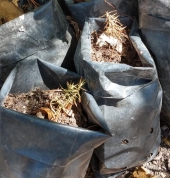posted 2 years ago
I'm starting this topic in hopes that others in a similar geography and climate can exchange experiences and information about homesteading and farming in these conditions.
These are the Andes mountains, an area that is arid but with a hefty rainy season with a couple good "hailstorms" every year.
Around 3500 meters altitude (well, throw a rock and you're at 3800 or 3400), pretty consistent temperatures year around compared to the US. Rainy season is potato bonanza bazaar. Dry season (with irrigation) is great for carrots and cabbage.
I run the rocket heater more in the daytime during "summer rains" because, obviously enough, there's way less sunshine.
Exact climate zoning is pretty unique to every point on the map because of the rapid changes in altitude and what angle a patch of land has toward the sun, and how long the rainy season is. One homestead might be at 13,000 feet but only 1000 feet above the nearest valley floor, another might be at 7000 feet but but 2500 feet above the nearest floors. I'm no topographer, and I grew up in flatlands, but I suspect relative altitude has some impact on the bioculture (as we can see with treelines), rather than just absolute altitude. You can physically visualize different rainy seasons too-- it starts raining daily within our line of sight in several mountainous cul-de-sacs, weeks before it gets to us. So my specific rainy season is approximately December through April, but can start up in September and end in June.
We have a corral with a couple goats, chickens, ducks, and... wild guinea pigs. They're surely eating more than their share of the forage, but so far we can't be bothered to exterminate them.
I'm new to homesteading anyway, so I don't always know what I don't know. Up front, is there any "must knows" about living at 3500 meters and caring for laying hens, goats, ducks? Can I grow American sweet corn in this climate? I'm really interested in knowing whether altitude affects anything I need to know about soil management. (Touch it and it falls 3 feet closer to the ocean, but I'm really wondering about soil chemistry, haha). The human metabolism functions differently at extreme altitudes so I figure maybe soil chemistry and nutrient uptake in plants could be different too.

 5
5




 2
2




 2
2





 1
1





 1
1




 1
1




 2
2





 1
1














